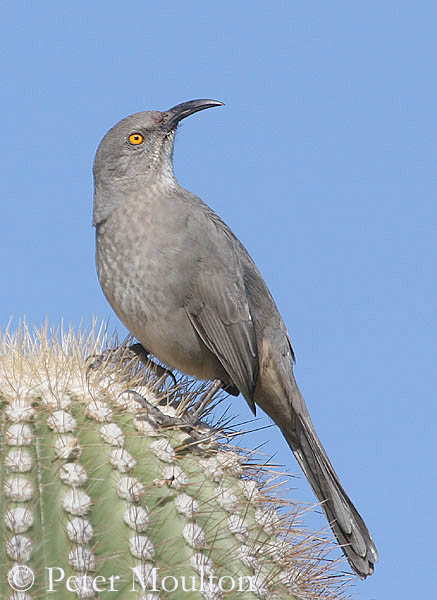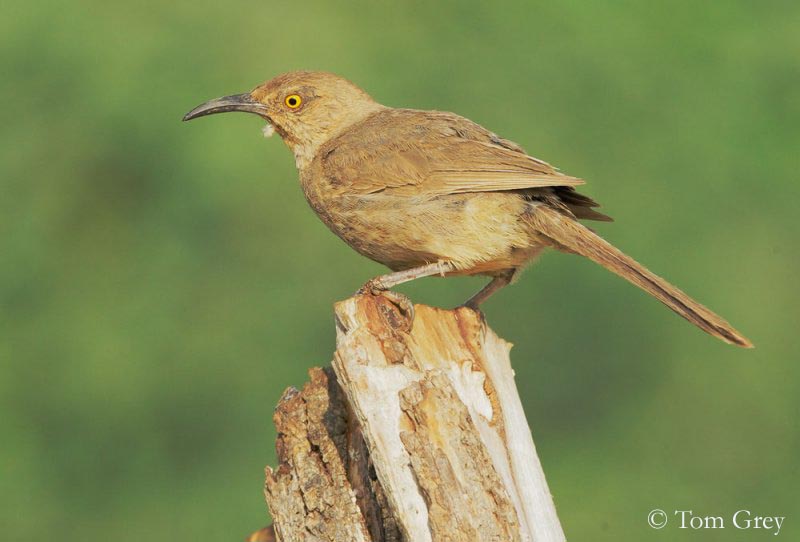
Curve-billed Thrasher
Toxostoma curvirostre
BIOMETRICS:
Length: 27 cm ; Wingspan: 34 cm ; Weight: 85 g
LONGEVITY: up to 10 years

DESCRIPTION:
Curve-billed Thrasher has greyish-brown body, with whitish mottled breast, white throat, and long and large tail with whitish corners. Both sexes are similar and belong to the east species.
Eyes are orange. It has long, slender, down curved black bill. Legs and feet are blackish.
Immature resemble adults, but the bill is shorter and straighter, and the eyes are rather yellow than orange.
Western race T.c. palmeri has indistinct spots on breast.
Extreme south-eastern Arizona and south Texas race, T.c.oberholseri, has paler spots below, pale wing bars and white tips on tail.
We can find similar species such as Bendire’s Thrasher (T. bendirei) has shorter and straighter bill and yellower eyes, and Crissal Thrasher (T.crissale) has pale breast and dark rusty undertail coverts.
VOICE: SOUNDS BY XENO-CANTO
Curve-billed Thrasher’s call is a double whistle “whit-wheet”, sometimes with three notes. Elaborate and melodic song includes low trills and warbles.
HABITAT:
Curve-billed Thrasher is common in canyons and semi-arid bushlands, in open brushy woodlands, and around farms, ranches and towns.
RANGE:
Curve-billed Thrasher is resident from southern Arizona to south-western Colorado to the Texas coast, and southwards to southern Mexico.
BEHAVIOUR:
Curve-billed Thrasher is a good singer, and often sings from the top of cactus.
It forages on the ground, and it is a rapid runner. It uses its strong down curved bill, to dig into soil for invertebrates. It probes the leaf litter, using side to side sweeping motions of the curved bill. Berries and fruits are eaten while perched.
Curve-billed Thrasher roosts in tall tree or spring vegetation, often cactus. It is bold and inquisitive.
FLIGHT:
Curve-billed Thrasher flies from bush to bush in a quick and jerky manner. Long flights are swift and direct, with rapid wing beats. It performs short flights with shallow wing beats, alternated with short periods of wings at sides, or short glides.

REPRODUCTION:
Curve-billed Thrasher’s nest is located in a dense thorny shrub, or in a clump of cactus, at about 2 to 8 feet above the ground.
Nest is made with twigs and rootlets, and lined with fine materials such as twigs and grass. It is a loose open cup which may include thorny twigs. Both adults build the nest.
Curve-billed Thrasher is monogamous, solitary nester and mates for life.
Female lays 1 to 5 pale blue green eggs, spotted with pale brown. Incubation lasts about 12 to 15 days, by both parents, but mostly by female. Chicks hatch altricial, and fledge at about 14 to 18 days after hatching.
This species produces two broods per season.
DIET:
Curve-billed Thrasher eats mostly seeds and insects, such as beetles, ants, crickets and grasshoppers. It also consumes berries and cacti fruits. It frequents bird feeders where fruit is available.
PROTECTION / THREATS / STATUS:
Curve-billed Thrasher is threatened by habitat loss, in south Texas brushland habitat and Arizona where cities are expanding.
But in Sonora, Mexico and parts of the southwest, resistant grass has been introduced, forming a suitable habitat. Also in south Texas, extensive works are restoring and protecting the native vegetation.
Fr: Moqueur à bec courbe
All : Krummschnabel-Spottdrossel
Esp : Cuitlacoche de Pico Curvo
Ital : Mimo beccocurvo
Nd :Krombecspotlijster
Sd : Bagnäbbad härmtrast
Pete Moulton
Pete Moulton Photography
Tom grey
Tom Grey's Bird Pictures
Texte de Nicole Bouglouan
Sources :
FIELD GUIDE TO THE BIRDS OF NORTH AMERICA - National Geographic Society - ISBN: 0792274512
All About Birds (Cornell Lab of Ornithology)
What Bird-The ultimate Bird Guide (Mitchell Waite)
Wikipedia (Wikipedia, The Free Encyclopedia)
Animal Diversity Web (University of Michigan Museum of Zoology)